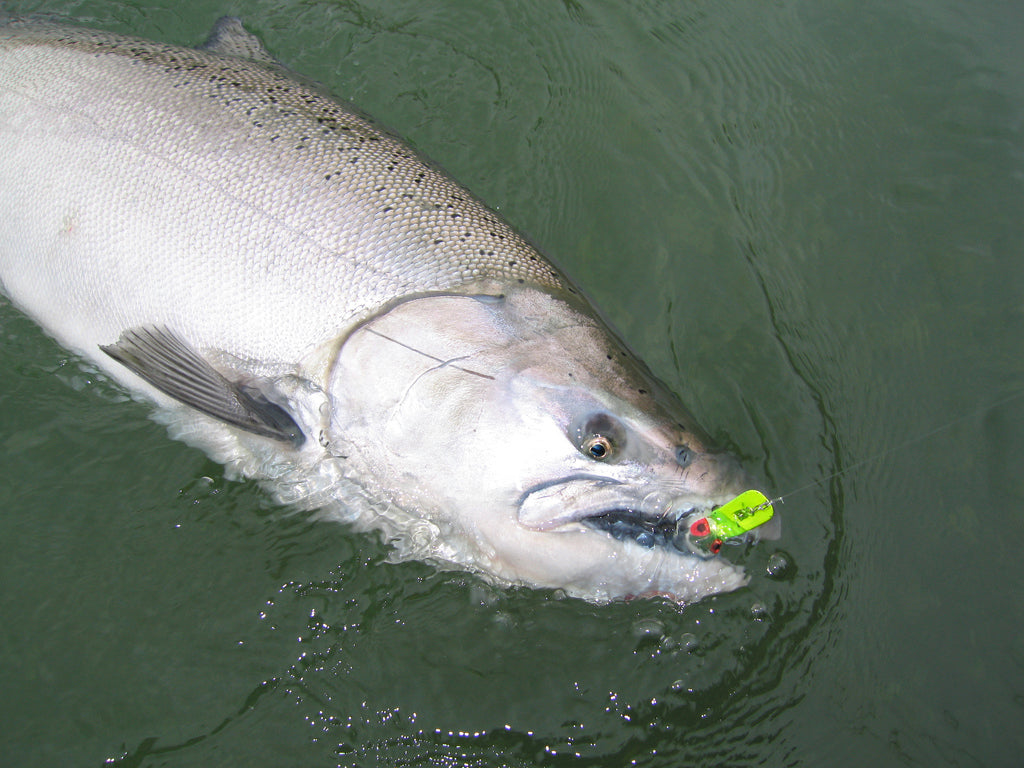Springers!
This time of year it’s hard for me to think about anything besides these chrome bullets that are making their way up rivers all up and down the West Coast right now.
My feelings for these amazing fish are incredibly strong. The word “passion” just doesn’t even do it justice—it’s more like extreme, over-the-top, out of control addition. And I know you know what I’m talking about here!
So, to help me feel a little better about sitting in front of this computer today, I’m going to at least think about springer fishing and throw out a few basic concepts. Hopefully, these will help those of you out there who haven’t yet had an encounter with one of the most bad-arse fish that swims. A word of caution: be prepared to get absolutely hooked!

Fish Early
Springers can be moody buggers so your best chance to get at them is right at first light. When the sun gets high and there’s lots of light penetration in the water, fishing typically grinds to a halt. On clear streams, I’m usually thinking about wrapping things up no later than 10 a.m. Now, if you are fishing really deep water or on a river that has lots of color, the bite window stays open longer.
That is also true on cloudy/foggy days. Basically: the darker the day, the better.
Fish Green
I’m not totally sure how to explain it, but springers seem to have a soft spot in their hearts for green. Yes, the traditional chartreuse that we use on plugs and spinners for fall chinook works, but I have more confidence when springer fishing when I also have some darker green mixed in too. Most of the spinners and plugs I use have dark green, chartreuse, and gold in combination. A close second is a chartreuse and metallic blue.
I also keep those principles at the forefront of my mind when choosing flasher and herring brine colors for springer trolling.
Now, color schemes for lures and baits vary from river to river and everybody has their local favorite, but the above combos will definitely get you in the ballgame.
Fish The Inside of Bends
When they hit the lo
wer end of a river system, spring Chinook are on a mission to get up to their summering grounds well upstream. As quickly as possible. So that means when they are down low, they don’t spend much time holding. Instead, springers pretty much put their heads down and start marching upriver. They will cut the corners of a river and rest very infrequently (until they get up closer to where they are going).
While trolling is the way to go on a massive river like the Columbia, springer anglers on smaller streams tend to anchor up. What you’re trying to do here is figure out a travel lane and then post on up that spot and put some lures in their paths. On rivers like the Klamath and Rogue, for example, the best places to drop the pick are in 3 to 6 feet of water on the inside of river bends.
Try to get your gear right in on the seam where the fast water of the main river transitions into the slow stuff on the inside.
When anchored on a spot like that, you’ll usually have to use heavier lead on the outside rods and lighter sinkers on the ones positioned on the soft side.
Fish Low
Unless I’m targeting springers in the upper sections of a river, where they stack up in deep holes, I like to fish as low in a system as I can—as close to the tide as possible. The fish usually come in on the flood in big wads and are at their most concentrated then. As they move upriver, they start to string out and the groups of fish will be fewer and farther between. That’s not to say you can’t catch them but the gaps between pulses are going to be longer.
Fish Tuna
Springers are very scent conscious and you’ll always do better by lathering your gear in some sort of fish “sauce.” As with lure color, there are lots of local variations here but one of the more common themes with springers is they like tuna. Tuna wraps on plugs, tuna liquid squirted on spinners and tuna mixed into spawn sacs with eggs. On Northern California’s Trinity River, straight tuna balls (wrapped in Moline bags) have been a spring salmon staple for eons.
When using tuna from a can, be sure to buy the oil pack variety!
In addition to tuna, I like anise but again, don’t be afraid to experiment.
Fish Soft
I generally use rods with softer tips when fishing springers than I do for fall fish. Spring chinook have a way of violently mashing lure or bait and I feel that extra “give” in the tip section helps keep fish from pulling off on the strike and initial run.
Of course, you’ll still need lots of backbone in the lower two-thirds of your stick so you can tame one of these wild, crazy beasts.

Sometimes the trick to springers, is using smaller lures.
Fish Small
When things get tough for springers, try scaling down the size of your gear. I’ve caught tons of spring salmon on small plugs and spinners intended for steelhead—so many in fact, that I’ve got an entire section in my box set aside for small lures.
By downsizing, you can sometimes get fish with lockjaw to bite again.
- written by JD Richey

